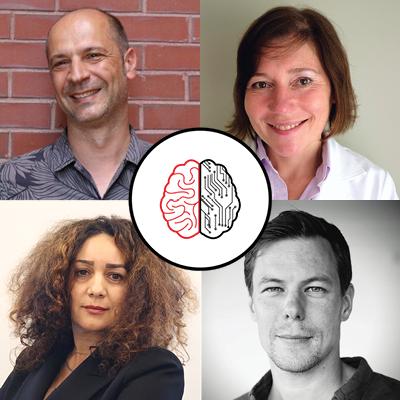
Carney researchers have developed a diagnostic technique that has the potential to improve outcomes for patients suffering from Normal Pressure Hydrocephalus (NPH), a neurological disorder leading to dementia that represents between five to 10% of all dementia cases. This research also adds new biomarkers to the neurodegenerative disease landscape—an important contribution in the mission to map genetic signatures for neurodegenerative diseases amongst the estimated 20,000 to 25,000 genes in our bodies.
The team of Provost’s Associate Professor of Brain Science Alexander Fleischmann, director of the Center for CSF Disorders of the Brain and Spine Petra Klinge, associate director of the Center for Computational Brain Science Thomas Serre and project manager Maria Grazia Ruocco formed three years ago as a result of a successful Zimmerman Innovation Award in Brain Science proposal. The goal of the Carney-funded project was, for the first time, to combine neurosurgery, molecular biology and machine learning to address NPH, a progressive disease characterized by cognitive decline, urinary incontinence, and deficits in gait, motor, locomotion and balance. Predominantly affecting the elderly, NPH patients are also more susceptible to developing Alzheimer’s disease.
The group analyzed the cerebrospinal fluid (CSF) of NPH patients undergoing shunt surgery, the most effective treatment for the disease, where a surgeon implants a shunt into a patient’s ventricles in order to drain excess CSF into the abdomen. Approximately half of all patients with NPH improve their mobility and normal cognitive function. Of the other approximate 50% of NPH patients, shunt surgery has no benefit, and comes with added risks including inflammation at the surgical sites, shunt blockage or infection and bowel perforation.
In a paper published May 20, 2023 in Brain, the group describes a new diagnostic approach that will enable clinicians and patients to learn the likely outcome of shunt surgery before any surgical intervention is undertaken. Dr. Klinge and her team collected CSF from 42 study participants suffering from NPH who underwent shunt surgery. Fleischmann and his team then performed RNA sequencing on the extracellular vesicles in patients’ CSF. From these samples, they successfully identified a biomarker signature for the patients who benefitted from surgery as well as a biomarker for patients who did not. Once they obtained these molecular signatures, Fleischmann and Serre’s teams were then able to use machine learning to develop an algorithm capable of predicting patients’ responses to shunt surgery.
This algorithm’s success rate of predicting which patients will positively respond to this treatment is 80% accurate, far exceeding the current accuracy of approximately 50%. Further, the identification of new biomarkers for neurodegenerative diseases is a real win in the battle to diagnose patients correctly, and thereby offer them the best care.
“Dementia and neurodegenerative diseases are so debilitating for patients and families that any new tools or markers, like the ones we identified, can have a huge impact on patients and clinicians,” said 2022 Brown graduate Zach Levin, the study’s first author and a former member of the Fleischmann Lab. “I view any improvement over a 50% response rate as a promising step, especially given the risks of this particular procedure.”
As a multidisciplinary team operating at two different sites (Brown’s main campus and Rhode Island Hospital), the group needed to develop new protocols for handling and analyzing CSF. The already-difficult process of recruiting and liaising with study participants (the team conducted check-ups at three, six and twelve months post-surgery) was made more complex by the pandemic slowing down recruitment and restricting opportunities for follow-up.
While clinicians and research scientists traditionally work independently from one another, this initiative called for the group to identify and break down barriers in order to become excellent collaborators.
“Clinicians work differently from academic researchers,” explained Ruocco, the immunologist who initially conceived of and currently coordinates all aspects of the complex project. “Their process is determined by the rate of patient recruitment and retention, and the urgency of the need for intervention. Maintaining regular communication between the neurosurgeon and the researcher can be difficult because the neurosurgeon can be needed in the operating room anytime. So it is up to our team spirit to make sure we share and communicate.”
That team spirit, and the existence of such a team at all, was only possible because of Carney, said Fleischmann. “To get such a high-risk, high-reward, interdisciplinary project started from scratch and funded would have been very difficult without Carney. The scientific community that Carney generates, where these conversations are encouraged and supported, is very important.”
Looking ahead, the group wants to replicate their findings in a larger sample size, and devise a protocol for collecting CSF from patients before surgery. As this takes place, there is great potential for more important knowledge to be uncovered since the researchers, in order to bring the work to this stage, have successfully built what Fleischmann calls “a pipeline that integrates clinical, molecular and data science approaches.”
“We have access to patients. We have new unbiased transcriptome-wide molecular signatures, which really allow for the discovery of new biomarkers. And we have the computational machine-learning tools in place to actually pull them out,” Fleischmann explained.
“We just set the first step,” added Ruocco. “As a team we are now prepared and committed for the biggest challenge: to take this forward and bring our biomarker test to hospitals. It is all very exciting!”